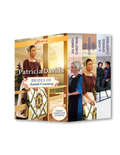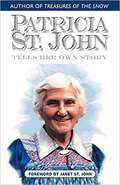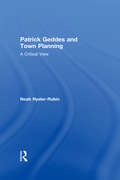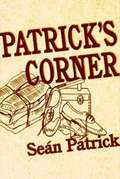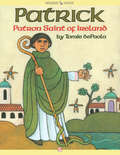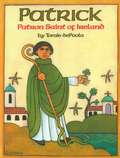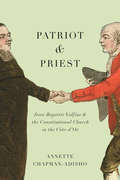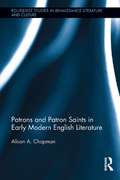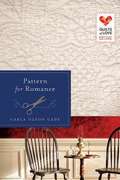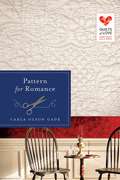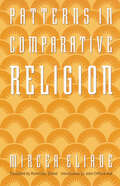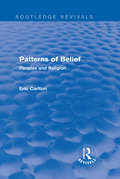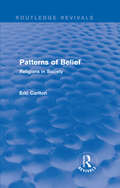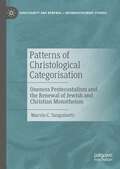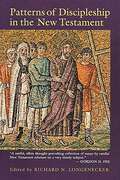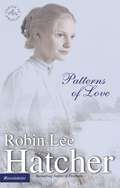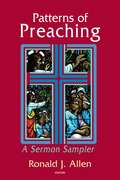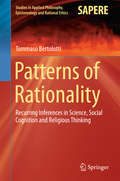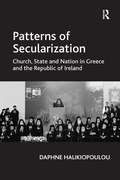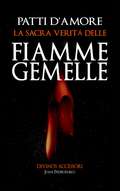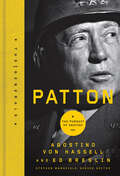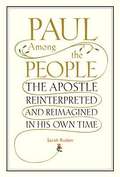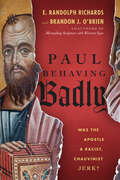- Table View
- List View
Patricia Davids Christmas Brides of Amish Country
by Patricia DavidsAN AMISH CHRISTMASWhen Karen Imhoff finds a beaten man lying unconscious by the road in her Amish community, she doesn't hesitate to help. "John Doe" needs a place to stay while he regains his memory, and she has a room to rent. The handsome Englisher proves invaluable around the family farm, yet his presence wreaks havoc with her emotions. Karen has her younger siblings to care for. She can't fall for an outsider who doesn't know his own identity...THE CHRISTMAS QUILTYears ago, Rebecca Beachy kept her reasons for rejecting Gideon Troyer's marriage proposal a secret. Then Gideon left their Amish community. Now, Rebecca crafts quilts to raise money to cure her blindness, and carefully guards her heart against love. Then Gideon returns, at risk of being shunned, to make the winning bid on one of her exquisite quilts. Will Rebecca's quilt-a patchwork promise of rediscovered love-bring Gideon and Rebecca back together again?A HOPE SPRINGS CHRISTMASWhen Amish buggy maker Levi Beachy turns the tables on matchmaker Sarah Wyse, they just might discover they've already found their perfect match-in each other.
Patricia St. John Tells Her Own Story
by Patricia St. JohnAnyone who has read Patricia St. John’s books already knows how her stories come alive, and this account of her own life is no exception. Her powers of description make the story leap from the page and the reader is transported to far off places and times; and the people and the things she describes can almost be touched, smelled and seen. <p><p> Patricia was not just a gifted story-teller, though; she was also a deeply committed follower of the Lord Jesus Christ, whose spiritual journey began when she was only six years old. ‘My name is Patricia, ’ she prayed, ‘and if You are really calling me I want to come and be Yours. ’ Out of that small beginning there issued a river of life and light and blessing that went on increasing right up to the end of her life. Although she always thought of herself as ‘an ordinary sort of girl’ , her life was extraordinary because of her supreme love for Jesus Christ. <p><p> The life portrayed here is not that of the self-conscious saint, concerned only with her own saintliness. On the contrary these pages offer us an inside view of someone utterly human, prone to mistakes and failures like the rest of us, yet suffused with the love of God and a contagious joy and peace that was like the bubbling up of a perpetual fountain.
Patrick Geddes and Town Planning: A Critical View
by Noah Hysler-RubinPatrick Geddes is considered a forefather of the modern urban planning movement. This book studies the various, and even opposing ways, in which Geddes has been interpreted up to this day, providing a new reading of his life, writing and plans. Geddes' scrutiny is presented as a case study for Town Planning as a whole. Tying together for the first time key concepts in cultural geography and colonial urbanism, the book proposes a more vigorous historiography, exposing hidden narratives and past agendas still dominating the disciplinary discourse. Written by a cultural geographer and a town planner, this book offers a rounded, full-length analysis of Geddes' vision and its material manifestation, functioning also as a much needed critical tool to evaluate Modern Town Planning as an academic and practical discipline. The book also includes a long overdue model of his urban theory.
Patrick's Corner
by Seán Patrick[Back cover] "Upon reaching their "two-digit" birthdays, the six Patrick brothers became "Associate Breadwinners" in order to help out their widowed mother and earn a little money to jingle in their pockets. Patrick's Corner, the busiest street corner in town, was so named by the Patricks because they had a sort of monopoly on working the crowded locale, shining shoes and hawking the evening newspaper. With age, when one brother would move on to more lucrative pastures, the next Patrick in line would take over his job. Sean Patrick, the baby of the family, tells the story of his "comin' up" in an Irish Catholic family that was financially poor, but rich with guidance, love, respect, and support. Patrick's Corner is a collection of stories about growing up after World War II in a world where family life, neighborhood interdependence, and nurturing environments were the norm. With a strong emphasis on familial relationships, Patrick's Corner shows the best side of people living in crowded poverty as a reminder that the family has always been the basic strength of America. Almost everyone will find something to relate to in this book, whether it is the struggle for self-identity, the family's faith in God, or the tendency of older siblings to act like parents. Even if you have never had to wear hand-me-down clothes or been referred to as So-and-So's little brother or sister, these stories are sure to touch your heart. Told with sensitivity and humor, this nostalgic and sometimes bittersweet reminiscence is full of warmth, love, growing pains, and the day-to-day struggles for survival. "
Patrick, Patron Saint of Ireland
by Tomie DepaolaThe story of Patrick's life, from his noble birth in Britain, to his being captured and taken to Ireland by a group of bandits, to the "dreams" that led him to convert the Irish people to the Christian faith. DePaola also retells several well-known legends, including the story of how Patrick got rid of all the snakes in Ireland.
Patrick: Patron Saint of Ireland
by Tomie DepaolaFrom his noble birth in Britain to his being captured and taken to Ireland by a group of bandits to the "dreams" that led him to convert the Irish people to the Christian faith, the story of Patrick is told. Four of the miracles he is believed to have performed are also described.
Patriot and Priest: Jean-Baptiste Volfius and the Constitutional Church in the Côte-d'Or (McGill-Queen's Studies in the History of Religion #2.86)
by Annette Chapman-AdishoIn 1790, the French revolutionary government reformed the Catholic Church and demanded that clerics swear an oath of allegiance to the nation and its vision for French Catholicism. Although half of France's parish clergy refused to accept the state-sponsored reforms, others became embroiled in this decade-long ecclesiastical experiment. This included Jean-Baptiste Volfius, a patriot, priest, and professor who embraced the changes in France and believed in the revolution's potential to create a purer church. Patriot and Priest presents a social and intellectual history of the French constitutional church in the Côte-d'Or and the career of Volfius, who became its bishop in 1791, as he struggled to create and run the church. Annette Chapman-Adisho addresses the daily experience of the constitutional clergy over the course of ten years, exploring the interactions between priests and local and national authorities, the response of the laity to the divisions in the French Catholic Church, the evolution of these issues over time, and the eventual reconciliation of the clergy following the Napoleonic Concordat with Pope Pius VII in 1801. Using a rich collection of archival sources, this book demonstrates that although the constitutional church was ultimately a failed project, its legacy had a lasting impact on the catholic Church in France. Tracing the social, political, and theological history of this reform effort, Patriot and Priest offers new insights into the French Revolution and its impact on French Catholicism.
Patristic Theories of Biblical Interpretation
by Tarmo ToomThis volume provides an in-depth analysis of patristic hermeneutics for those who research, teach, or study the early church and the interpretation of Scripture. It focuses exclusively on Latin authors - such as Jerome, Augustine, and Gregory - whose writings contain substantial discussion of hermeneutics and who were known, read, and cited in the Middle Ages and beyond. In this collection of essays, leading international experts in the field identify key passages on patristic hermeneutical theory and demonstrate how the works of these authors have been fundamental for Latin traditions of biblical interpretation. Patristic Theories of Biblical Interpretation offers a selective yet comprehensive guide to a previously understudied area.
Patrons and Patron Saints in Early Modern English Literature (Routledge Studies in Renaissance Literature and Culture)
by Alison ChapmanThis book visits the fact that, in the pre-modern world, saints and lords served structurally similar roles, acting as patrons to those beneath them on the spiritual or social ladder with the word "patron" used to designate both types of elite sponsor. Chapman argues that this elision of patron saints and patron lords remained a distinctive feature of the early modern English imagination and that it is central to some of the key works of literature in the period. Writers like Jonson, Shakespeare, Spenser, Drayton, Donne and, Milton all use medieval patron saints in order to represent and to challenge early modern ideas of patronage -- not just patronage in the narrow sense of the immediate economic relations obtaining between client and sponsor, but also patronage as a society-wide system of obligation and reward that itself crystallized a whole culture’s assumptions about order and degree. The works studied in this book -- ranging from Shakespeare’s 2 Henry VI, written early in the 1590s, to Milton’s Masque Performed at Ludlow Castle, written in 1634 -- are patronage works, either aimed at a specific patron or showing a keen awareness of the larger patronage system. This volume challenges the idea that the early modern world had shrugged off its own medieval past, instead arguing that Protestant writers in the period were actively using the medieval Catholic ideal of the saint as a means to represent contemporary systems of hierarchy and dependence. Saints had been the ideal -- and idealized -- patrons of the medieval world and remained so for early modern English recusants. As a result, their legends and iconographies provided early modern Protestant authors with the perfect tool for thinking about the urgent and complex question of who owed allegiance to whom in a rapidly changing world.
Pattern for Romance
by Carla Olson GadeHonour Metcalf's quilting needlework is admired by a wealthy customer of the Boston Mantua-maker for whom she works. In need of increasing her earnings, she agrees to create an elaborate white work bridal quilt for the dowager's niece. A beautiful design emerges as she carefully stitches the intricate patterns and she begins to dream of fashioning a wedding quilt of her own. When Honour is falsely accused of thievery and finds herself in a perilous position, merchant tailor Joshua Sutton comes to her aid. As he risks his relationships, reputation, and livelihood to prove her innocence, the two discover a grander plan--a design for love.
Pattern for Romance
by Carla Olson GadeHonour Metcalf's quilting needlework is admired by a wealthy customer of the Boston Mantua-maker for whom she works. In need of increasing her earnings, she agrees to create an elaborate white work bridal quilt for the dowager's niece. A beautiful design emerges as she carefully stitches the intricate patterns and she begins to dream of fashioning a wedding quilt of her own. When Honour is falsely accused of thievery and finds herself in a perilous position, merchant tailor Joshua Sutton comes to her aid. As he risks his relationships, reputation, and livelihood to prove her innocence, the two discover a grander plan--a design for love.
Patterns in Comparative Religion
by Mircea EliadeIn this era of increased knowledge the essence of religious phenomena eludes the psychologists, sociologists, linguists, and other specialists because they do not study it as religious. According to Mircea Eliade, they miss the one irreducible element in religious phenomena—the element of the sacred. Eliade abundantly demonstrates universal religious experience and shows how humanity&’s effort to live within a sacred sphere has manifested itself in myriad cultures from ancient to modern times; how certain beliefs, rituals, symbols, and myths have, with interesting variations, persisted.
Patterns of Belief: Peoples and Religion (Routledge Revivals Ser.)
by Eric CarltonThe principle purpose of Religious Education has traditionally been to instruct and inform, with discussion and questioning occupying a secondary position. This traditional approach gives overwhelming emphasis to the historical aspects of religion, and not only fails to put into perspective the issues raised by religion today, but also takes no account of the growing movement in schools towards learning by enquiry and questioning rather than by the accumulation of stated facts. This title, first published in 1973, explores the ways in which religion can be approached from a more sociological standpoint, and aims to encourage the reader to examine religion in a more objective manner. The wide-ranging and exploratory theme of this book makes it ideal for follow-up work and suggestions for further study are provided after each chapter. This title will be of interest to teachers and students of Religious Studies.
Patterns of Belief: Religions in Society (Routledge Revivals Ser.)
by Eric CarltonThe principle purpose of Religious Education has traditionally been to instruct and inform, with discussion and questioning occupying a secondary position. This traditional approach gives overwhelming emphasis to the historical aspects of religion, and not only fails to put into perspective the issues raised by religion today, but also takes no account of the growing movement in schools towards learning by enquiry and questioning rather than by the accumulation of stated facts. This title, first published in 1973, explores the ways in which religion can be approached from a more sociological standpoint, and aims to encourage the reader to examine religion in a more objective manner. The wide-ranging and exploratory theme of this book makes it ideal for follow-up work and suggestions for further study are provided after each chapter. This title will be of interest to teachers and students of Religious Studies.
Patterns of Christological Categorisation: Oneness Pentecostalism and the Renewal of Jewish and Christian Monotheism (Christianity and Renewal - Interdisciplinary Studies)
by Marvin C. SanguinettiThis book focuses on Christological-Monotheism, an underexplored area which combines two disciplines of theological appraisal often addressed as separate subjects. Christological-Monotheism is underexplored in the literature, and even more underexplored are interpretations of Christological-Monotheism from the perspectives of Christian voices within the “Oneness Pentecostal” faith tradition. Oneness Pentecostalism offers opposing perspectives to what is considered ‘fixed orthodoxy’ within the Christian faith traditions: i.e., its views differ on doctrines relating to the nature of God and Christ from accepted norms. This project seeks to include various Oneness Pentecostal interpretations to commonly held perspectives, and explore what such might look like when juxtapose with Christian orthodoxy. Moreover, it rereads perspectives about the relationship between God and Christ offered by both traditions in the contexts of earlier contributors to Christian history, all the way to the Second Temple Jewish periods, and includes similar patterns exposed by various groups/scholars along this trajectory.
Patterns of Discipleship in the New Testament
by Richard N. LongeneckerDiscipleship is a subject that lies at the heart of Christian thought, life, and ministry. For centuries it has been a way of thinking and speaking about the nature of the Christian life. But what is actually meant by the notion of "Christian discipleship"? In Patterns of Discipleship in the New Testament thirteen first-class scholars examine what the New Testament writings say about the subject of discipleship, highlight the features of both unity and diversity that appear throughout the New Testament, and suggest, in a very readable style, how Christian discipleship can be expressed today in ways that honor both the oneness of the gospel and a legitimate variety of lifestyles.
Patterns of Love (Coming to America #2)
by Robin Lee HatcherMy dear Beth, Though Uppsala, Iowa, takes its name from a city in my native Sweden, life here is different from what I have known. With my parents’ blessing, I have taken employment in the home of Mr. Bridger, a dairy farmer, caring for his ill mother and two young, orphaned nieces. It is most unlike me to leave home, even in a temporary manner. But the need is great and Hattie Bridger and the children are so endearing. As for Dirk Bridger, he is an unhappy man, but also loyal, hardworking, and honorable. And, I should add, quite handsome. My younger sisters were smitten the instant they saw him. Young flirts! And with beauty to match. I, on the other hand, am considered to have common sense to attend my common looks. But, friend Beth, I am afraid my heart betrays my wisdom—for I, too, long to be seen as beautiful. Not just by anyone. By Dirk Bridger. Your friend, Inga Linberg In rural Iowa, life is both the planter and uprooter of dreams. As love, long delayed, springs to life in the heart of a young Swedish immigrant, one man struggles with his withered ambitions—and new blessings that could take their place if he would but allow them room. Patterns of Love is Book Two in the Coming to America series about women who come to America to start new lives. Set in the late 1800s and early 1900s, these novels by best-selling author Robin Lee Hatcher craft intense chemistry and conflict between the characters, lit by a glowing faith and humanity that will win your heart. Look for other books in the series at your favorite Christian bookstore.
Patterns of Preaching: A Sermon Sampler
by Ronald J. AllenThis collection of sermons by noted homileticians illustrates thirty-four distinct styles of contemporary and traditional preaching.
Patterns of Rationality
by Tommaso BertolottiThis book proposes an applied epistemological framework for investigating science, social cognition and religious thinking based on inferential patterns that recur in the different domains. It presents human rationality as a tool that allows us to make sense of our (physical or social) surroundings. It shows that the resulting cognitive activity produces a broad spectrum of outputs, such as scientific models and experimentation, gossip and social networks, but also ancient and contemporary deities. The book consists of three parts, the first of which addresses scientific modeling and experimentation, and their application to the analysis of scientific rationality. Thus, this part continues the tradition of eco-cognitive epistemology and abduction studies. The second part deals with the relationship between social cognition and cognitive niche construction, i. e. the evolutionarily relevant externalization of knowledge onto the environment, while the third part focuses on what is commonly defined as "irrational", thus being in a way dialectically opposed to the first part. Here, the author demonstrates that the "irrational" can be analyzed by applying the same epistemological approach used to study scientific rationality and social cognition; also in this case, we see the emergence of patterns of rationality that regulate the relationships between agents and their environment. All in all, the book offers a coherent and unitary account of human rationality, providing a basis for new conceptual connections and theoretical speculations.
Patterns of Secularization: Church, State and Nation in Greece and the Republic of Ireland
by Daphne HalikiopoulouThe politicization of religion is a central feature of the modern world, pointing to the continued relevance of the secularization debate: does modernization result in the decline of the social and political significance of religion or rather in a reaffirmation of religious values? This book examines the emergence of different patterns of secularization. It identifies the circumstances under which religion may remain or cease to be politically active and legitimate in societies where secularization has been initially inhibited given a strong identification with the nation. Arguing that in such societies the Church draws its power not only from its relationship with the state but also its relationship with the nation, this book identifies two patterns of secularization: (a) co-optation, and (b) confrontation. The redefinition of the Church, state and nation nexus is likely to result in secularization if (a) the church obstructs the modernisation process (church and state), and (b) if external threat perceptions decline (church and nation). The simultaneous presence of these constraints serves to redefine the role of religion in the formation of national identity. Comparing Greece and the Republic of Ireland as two cultural defence cases with a strong variation in the political and social salience of religion, this book explains Ireland's current secularization drive in terms of the fluidity of Irish national identity and the rigidity of the Irish Catholic Church (confrontation). It contrasts this with the Greek case where the Church's resilience is linked to institutional flexibility on the one hand and a reliance on an ethnic/religious national identity on the other (co-optation). In conceptualizing the contemporary role of religion in the Republic of Ireland and Greece, this book draws a number of generalizable conclusions about the political role of religion in cultural defence cases.
Patti d'amore
by Juan Pedropablo Anna Del RisoFin dall'inizio della creazione, e per un lungo periodo di tempo della storia dell’umanità fino ad ora, alcune scintille divine hanno deciso di incarnarsi sulla terra. Fu allora che ebbero origine i Complementi Divini o anche chiamate Anime Gemelle, che dopo un processo di densificazione sono entrate nel nostro sistema solare per compiere la loro evoluzione esperienzale e ad un certo punto tornare a incontrarsi con un fine più alto e più sublime, ottenere l'ascensione, oppure tornare a casa. Queste Anime belle, che contengono l'essenza stessa della divinità, non sono qualcosa di lontano, qualcosa che appartiene a un altro mondo o dimensione. Molte di loro vivono e coesistono proprio qui sul nostro pianeta, in modo palpabile e tangibile come la vita stessa. “Alleanze d'Amore” ci presenta in modo semplice, pratico e rivelatore due storie di persone che hanno sperimentato questo magico incontro della loro essenza, attraverso le loro esperienze reali possiamo riconoscere e ricordare che l'Amore Eterno e Sacro è una Realtà . Non c'è dubbio che questo libro vi farà porre delle domande che ci porteranno ad indagare di più su questo entusiasmante tema e ci faranno ricordare dei percorsi che forse sono stati dimenticati. Una testimonianza scritta come un romanzo, che si incarna in parole ed eventi che rivelano al lettore la realtà dell'amore puro, concreto e spiritualizzato, vissuto ore e da sempre da tempo immemorabile. Un libro sui generis, una storia d'amore fatta di mail, messaggi ed esperienze. Un tuffo nei ricordi, un amore unico raccontato da due fronti. I protagonisti Mariela, José Marìa, Juan e Maria in un intreccio che confonde presente e passato, vivono l'esperienza dell'amore delle anime gemelle, fatto di esperienze extrasensoriali, momenti di domande e di esplosione di amore. Leggere questo romanzo vi farà riflettere sull'esistenza del vero amore, s
Patton: The Pursuit of Destiny (The Generals Series)
by Ed Breslin Agostino von HassellHe was a harsh taskmaster who comforted dying soldiers and quietly commended their valor. A crusty, often foulmouthed commander who wrote tender letters home to the love of his life.Gen. George S. Patton Jr. comes to life in these pages as one of the most colorful, enigmatic, and unfairly maligned leaders in U.S. military history. Often caricatured—as in the big-screen biopic, Patton—the general was a complex blend of battle-tested strengths and nearly fatal personal flaws.Without varnishing over his shortcomings, Patton: The Pursuit of Destiny shatters myths and builds a compelling case for a deeper appreciation of the man who inspired unsurpassed loyalty and admiration from the soldiers who served under him.Destined for an outsized life, Patton parlayed his family’s deep military roots, his World War I experiences, his Olympic exploits, and his passion for freedom to become one of the linchpins of Allied victory in World War II.
Paul Among Jews and Gentiles and Other Essays
by Krister StendahlKrister Stendahl looks at the Apostle Paul in new ways given the fact that Paul was Jewish and brought the gospel to the gentiles.
Paul Among the People
by Sarah RudenIt is a common--and fundamental--misconception that Paul told people how to live. Apart from forbidding certain abusive practices, he never gives any precise instructions for living. It would have violated his two main social principles: human freedom and dignity, and the need for people to love one another. Paul was a Hellenistic Jew, originally named Saul, from the tribe of Benjamin, who made a living from tent making or leatherworking. He called himself the "Apostle to the Gentiles" and was the most important of the early Christian evangelists. Paul is not easy to understand. The Greeks and Romans themselves probably misunderstood him or skimmed the surface of his arguments when he used terms such as "law" (referring to the complex system of Jewish religious law in which he himself was trained). But they did share a language--Greek--and a cosmopolitan urban culture, that of the Roman Empire. Paul considered evangelizing the Greeks and Romans to be his special mission. "For you were called to freedom, brothers and sisters; only do not use your freedom as an opportunity for self-indulgence, but through love become slaves to one another. For the whole law is summed up in a single commandment, 'You shall love your neighbor as yourself.'" The idea of love as the only rule was current among Jewish thinkers of his time, but the idea of freedom being available to anyone was revolutionary. Paul, regarded by Christians as the greatest interpreter of Jesus' mission, was the first person to explain how Christ's life and death fit into the larger scheme of salvation, from the creation of Adam to the end of time. Preaching spiritual equality and God's infinite love, he crusaded for the Jewish Messiah to be accepted as the friend and deliverer of all humankind. In Paul Among the People, Sarah Ruden explores the meanings of his words and shows how they might have affected readers in his own time and culture. She describes as well how his writings represented the new church as an alternative to old ways of thinking, feeling, and living. Ruden translates passages from ancient Greek and Roman literature, from Aristophanes to Seneca, setting them beside famous and controversial passages of Paul and their key modern interpretations. She writes about Augustine; about George Bernard Shaw's misguided notion of Paul as "the eternal enemy of Women"; and about the misuse of Paul in the English Puritan Richard Baxter's strictures against "flesh-pleasing." Ruden makes clear that Paul's ethics, in contrast to later distortions, were humane, open, and responsible. Paul Among the People is a remarkable work of scholarship, synthesis, and understanding; a revelation of the founder of Christianity.From the Hardcover edition.
Paul Behaving Badly: Was the Apostle a Racist, Chauvinist Jerk?
by E. Randolph Richards Brandon J. O'BrienThe apostle Paul was kind of a jerk.
